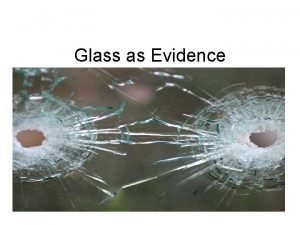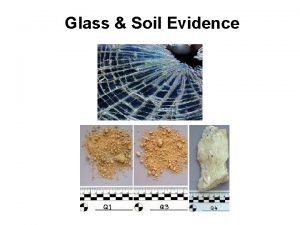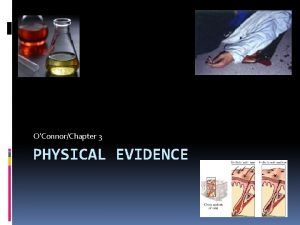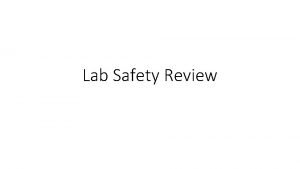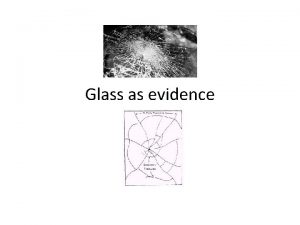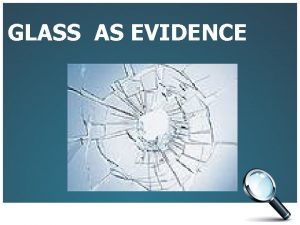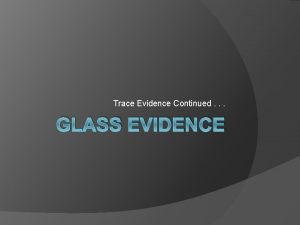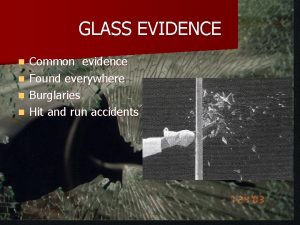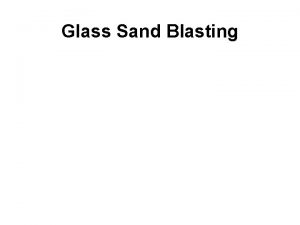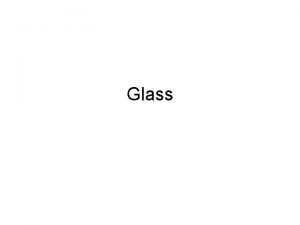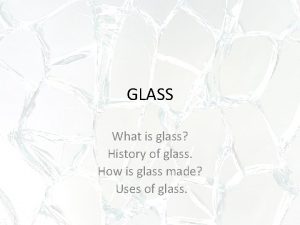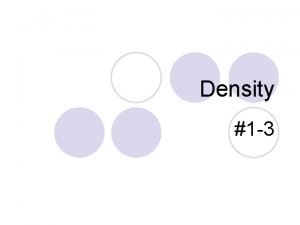Glass Evidence Density Common Examples When glass is




























- Slides: 28

Glass Evidence

Density - Common Examples When glass is found, density is one of the physical characteristics measured. Different types have different densities 2 Type of Glass Density (g/ml) Bottle glass 2. 50 Window glass 2. 53 Lead crystal 2. 98 -3. 01 Pyrex 2. 27 Tempered (auto) 2. 98 Flint 3. 70 Crown 2. 50 Forensic Science: Fundamentals & Investigations, Chapter 14

Crack patterns Radial cracks are first to form. They are on the side opposite to force. Concentric cracks form second, beginning on side of force.

Fractures Radial Concentric bsapp. com



bsapp. com

Determining Sequence It is possible to determine the order cracks occurred in, because new cracks stop when they hit old cracks.

Which bullet was fired first? 1 2

1 2 bsapp. com

1 2 bsapp. com

Determining Direction of Impact High speed projectiles like bullets often leave holes that are wider at the exit side.

What direction?

What direction, and in what order? 1 3 2


Speed of Impact Higher speed impacts produce fewer concentric fractures than lower speed impacts.

Path of a Bullet Passing through Window Glass The entry hole will be round if the bullet was fired perpendicular to the pane. If fired from an angle, glass pieces will be forced out to the opposite side from the shot. The angles at which bullets enter window glass can help locate the position of the shooter.

Backscatter Most glass fragments will be carried forward during impact, showing the direction force came from. Some will be projected backwards. This is backscatter, and is sometimes trace evidence found on the perpetrator.

Heat Fracture Extreme heat can break glass. causes wavy lines. It Glass will tend to break toward the area of higher temperature.

Picture courtesy of Kelsey Nelson

Bulletproof Glass Made of two or more layers of glass, and sometimes plastic to absorb impact.

Laminated Glass �Two layers of glass with plastic in middle. �Used in windshields, patio doors, etc. �Harder to recognize fracture patterns.

Tempered Glass is made stronger through the rapid heating and cooling of the glass surfaces. Chemicals can also be used to make this “toughened glass”. Tempered glass does not shatter, it “dices” into small squares Used in passenger windows

What is going on here?

Refractive Index Immersion – glass particles are immersed in liquid whose refractive index is varied until it is equal to that of the glass The “match point” is noted by the disappearance of the Becke Line –a bright halo that is observed near the border of a particle immersed in a liquid of a different refractive index

Refractive Index Becke Line - a halo-like effect appearing at the edges of a glass fragment when the reflective index of the glass and liquid are different If the line is inside the glass perimeter, the glass index is higher than the index of the liquid If the line is outside the glass perimeter, the glass index is lower Forensic Science: Fundamentals & Investigations, Chapter 14 26


Handling of Crime Scene Glass Samples 1. Identify and photograph any glass samples before moving them. 2. Collect the largest fragments that can be reasonably collected. 3. Identify the outside and inside surface of any glass. 4. If multiple panes are involved, make a diagram. 5. Note trace evidence such as skin, hair, blood, or fibers. 6. Package all materials collected to maintain the chain of custody.
 What is specific gravity
What is specific gravity Planar density
Planar density Physiological density vs arithmetic density
Physiological density vs arithmetic density Linear atomic density
Linear atomic density High density low density
High density low density What does arithmetic density tell us
What does arithmetic density tell us Primary evidence vs secondary evidence
Primary evidence vs secondary evidence Primary evidence vs secondary evidence
Primary evidence vs secondary evidence Secondary sources
Secondary sources Primary evidence vs secondary evidence
Primary evidence vs secondary evidence Jobs vancouver
Jobs vancouver Why are fibers considered class evidence
Why are fibers considered class evidence Class evidence vs individual evidence
Class evidence vs individual evidence Explain how class evidence can have probative value.
Explain how class evidence can have probative value. Class evidence vs individual evidence
Class evidence vs individual evidence Ecological fallacy
Ecological fallacy What is a becke line forensics
What is a becke line forensics Glass evidence in forensic science
Glass evidence in forensic science 3 examples of physical evidence
3 examples of physical evidence Slidetodoc.com
Slidetodoc.com Glass ceiling glass escalator
Glass ceiling glass escalator If an acid is splashed on your skin, wash at once with
If an acid is splashed on your skin, wash at once with Does hot glass look like cold glass
Does hot glass look like cold glass Common factors of 18 and 30
Common factors of 18 and 30 Common anode and common cathode
Common anode and common cathode Lowest common multiple of 80 and 60
Lowest common multiple of 80 and 60 Highest common factors and lowest common multiples
Highest common factors and lowest common multiples Common factors of 12 and 42
Common factors of 12 and 42 Highest common factors and lowest common multiples
Highest common factors and lowest common multiples
















